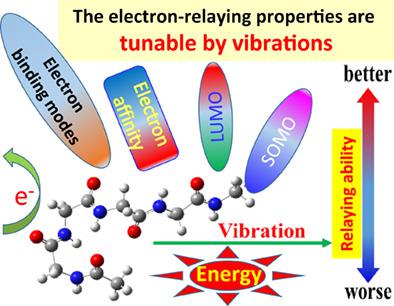当前位置:
X-MOL 学术
›
J. Comput. Chem.
›
论文详情
Our official English website, www.x-mol.net, welcomes your feedback! (Note: you will need to create a separate account there.)
Dynamic relaying properties of a β-turn peptide in long-range electron transfer
Journal of Computational Chemistry ( IF 3 ) Pub Date : 2018-11-19 , DOI: 10.1002/jcc.25541 Xiufang Song 1 , Fengying Zhang 1 , Yuxiang Bu 1
Journal of Computational Chemistry ( IF 3 ) Pub Date : 2018-11-19 , DOI: 10.1002/jcc.25541 Xiufang Song 1 , Fengying Zhang 1 , Yuxiang Bu 1
Affiliation

|
The relay stations play a significant role in long‐range charge hopping transfer in proteins. Although studies have clarified that many more protein structural motifs can function as relays in charge hopping transfers by acting as intermediate charge carriers, the relaying properties are still poorly understood. In this work, taking a β‐turn oligopeptide as an example, we report a dynamic character of a relay with tunable relaying properties using the density functional theory calculations. Our main finding is that a β‐turn peptide can serve as an effective electron relay in facilitating long‐range electron migration and its relay properties is vibration‐tunable. The vibration‐induced structural transient distortions remarkably affect the lowest occupied molecular orbital (LUMO) energy, vertical electron affinity and electron‐binding mode of the β‐turn oligopeptide and the singly occupied molecular orbital (SOMO) energy of the corresponding electron adduct and thus the relaying properties. Different vibration modes lead to different structural distortions and thus have different effects on the relaying properties and ability of the β‐turn peptide. For the relaying properties, there approximately is a linear negative correlation of electron affinity with the LUMO energy of the β‐turn or the SOMO energy of its electron adduct. Besides, such relaying properties also vary in the vibration evolution process, and the electron‐binding modes may be tunable. As an important addition to the known static charge relaying properties occurring in various protein structural motifs, this work reports the dynamic electron‐relaying characteristics of a β‐turn oligopeptide with variable relaying properties governed by molecular vibrations which can be applied to different proteins in mediating long‐range charge transfers. Clearly, this work reveals molecular vibration effects on the electron relaying properties of protein structural motifs and provides new insights into the dynamics of long‐range charge transfers in proteins. © 2018 Wiley Periodicals, Inc.
中文翻译:

β-转角肽在长程电子转移中的动态中继特性
中继站在蛋白质的长距离电荷跳跃转移中发挥着重要作用。尽管研究已经阐明,更多的蛋白质结构基序可以通过充当中间电荷载流子在电荷跳跃转移中起到中继作用,但中继特性仍然知之甚少。在这项工作中,以 β-转角寡肽为例,我们使用密度泛函理论计算报告了具有可调中继特性的继电器的动态特性。我们的主要发现是,β-转角肽可以作为有效的电子继电器促进长程电子迁移,并且其继电器特性是振动可调的。振动引起的结构瞬态畸变显着影响最低占据分子轨道(LUMO)能量,β-转角寡肽的垂直电子亲合力和电子结合模式以及相应电子加合物的单占分子轨道(SOMO)能量以及中继特性。不同的振动模式导致不同的结构扭曲,从而对β-转角肽的中继特性和能力产生不同的影响。对于中继特性,电子亲和力与 β 转角的 LUMO 能量或其电子加合物的 SOMO 能量近似呈线性负相关。此外,这种中继特性在振动演化过程中也会发生变化,并且电子结合模式可能是可调的。作为在各种蛋白质结构基序中发生的已知静电荷中继特性的重要补充,这项工作报告了 β-转角寡肽的动态电子中继特性,它具有由分子振动控制的可变中继特性,可应用于不同的蛋白质,以介导远程电荷转移。显然,这项工作揭示了分子振动对蛋白质结构基序的电子传递特性的影响,并为蛋白质中长程电荷转移的动力学提供了新的见解。© 2018 Wiley Periodicals, Inc. 这项工作揭示了分子振动对蛋白质结构基序的电子传递特性的影响,并为蛋白质中长程电荷转移的动力学提供了新的见解。© 2018 Wiley Periodicals, Inc. 这项工作揭示了分子振动对蛋白质结构基序的电子传递特性的影响,并为蛋白质中长程电荷转移的动力学提供了新的见解。© 2018 Wiley Periodicals, Inc.
更新日期:2018-11-19
中文翻译:

β-转角肽在长程电子转移中的动态中继特性
中继站在蛋白质的长距离电荷跳跃转移中发挥着重要作用。尽管研究已经阐明,更多的蛋白质结构基序可以通过充当中间电荷载流子在电荷跳跃转移中起到中继作用,但中继特性仍然知之甚少。在这项工作中,以 β-转角寡肽为例,我们使用密度泛函理论计算报告了具有可调中继特性的继电器的动态特性。我们的主要发现是,β-转角肽可以作为有效的电子继电器促进长程电子迁移,并且其继电器特性是振动可调的。振动引起的结构瞬态畸变显着影响最低占据分子轨道(LUMO)能量,β-转角寡肽的垂直电子亲合力和电子结合模式以及相应电子加合物的单占分子轨道(SOMO)能量以及中继特性。不同的振动模式导致不同的结构扭曲,从而对β-转角肽的中继特性和能力产生不同的影响。对于中继特性,电子亲和力与 β 转角的 LUMO 能量或其电子加合物的 SOMO 能量近似呈线性负相关。此外,这种中继特性在振动演化过程中也会发生变化,并且电子结合模式可能是可调的。作为在各种蛋白质结构基序中发生的已知静电荷中继特性的重要补充,这项工作报告了 β-转角寡肽的动态电子中继特性,它具有由分子振动控制的可变中继特性,可应用于不同的蛋白质,以介导远程电荷转移。显然,这项工作揭示了分子振动对蛋白质结构基序的电子传递特性的影响,并为蛋白质中长程电荷转移的动力学提供了新的见解。© 2018 Wiley Periodicals, Inc. 这项工作揭示了分子振动对蛋白质结构基序的电子传递特性的影响,并为蛋白质中长程电荷转移的动力学提供了新的见解。© 2018 Wiley Periodicals, Inc. 这项工作揭示了分子振动对蛋白质结构基序的电子传递特性的影响,并为蛋白质中长程电荷转移的动力学提供了新的见解。© 2018 Wiley Periodicals, Inc.


























 京公网安备 11010802027423号
京公网安备 11010802027423号